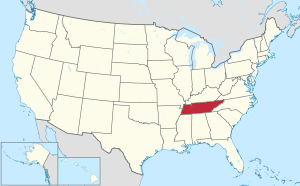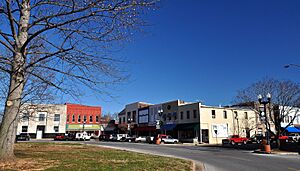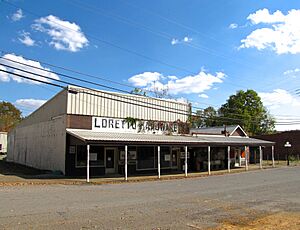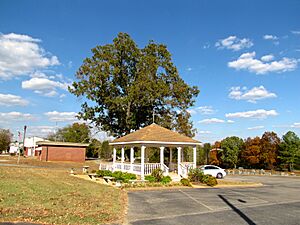Lawrence County, Tennessee facts for kids
Quick facts for kids
Lawrence County
|
||
|---|---|---|

Lawrence County Courthouse, January 2015
|
||
|
||

Location within the U.S. state of Tennessee
|
||
 Tennessee's location within the U.S. |
||
| Country | ||
| State | ||
| Founded | 1817 | |
| Named for | James Lawrence | |
| Seat | Lawrenceburg | |
| Largest city | Lawrenceburg | |
| Area | ||
| • Total | 618 sq mi (1,600 km2) | |
| • Land | 617 sq mi (1,600 km2) | |
| • Water | 0.9 sq mi (2 km2) 0.1%% | |
| Population
(2020)
|
||
| • Total | 44,159 | |
| • Estimate
(2021)
|
44,828 |
|
| • Density | 71.45/sq mi (27.589/km2) | |
| Time zone | UTC−6 (Central) | |
| • Summer (DST) | UTC−5 (CDT) | |
| Congressional district | 4th | |
Lawrence County is a place in Tennessee, a state in the United States. In 2020, about 44,159 people lived here. Its main city, called the county seat, is Lawrenceburg. This is also its biggest city. Lawrence County is part of a larger area that includes Nashville.
Contents
History of Lawrence County
Lawrence County was created on October 21, 1817. It was made from parts of Hickman and Giles counties.
The county was named after Captain James Lawrence (1781–1813). He was a brave naval officer. In 1813, during a battle, he famously said: "Don't give up the ship!"
Early Settlements and Growth
Lawrenceburg became the county seat in 1819. It was chosen because it was in the middle of the county. A very important road, called Jackson's Military Road, ran near the town. This road helped the county grow a lot.
An early resident of the county was David Crockett. He was a famous frontiersman and politician. Crockett lived in Lawrence County for several years. He ran a mill that used water power to grind grain and make gunpowder. He also had a distillery. Today, David Crockett State Park is located where his mills once stood.
New People and Industries
In the early 1870s, many German Catholics moved to the area. They brought new skills and trades. When the railroad arrived in 1883, Lawrence County became important for iron ore.
Between 1908 and 1915, more people moved in from Alabama. Many of them grew cotton or worked in the timber industry. Cotton remained a big crop until the 1960s.
In 1944, Amish people started a community in the north of the county. This Old Order Amish community is now a popular place for visitors.
Important Events
Lawrence County has been hit by two strong tornadoes. On May 18, 1995, a powerful F4 tornado struck the county. On April 16, 1998, an even stronger F5 tornado hit the area.
In 2010, the state of Tennessee officially recognized six Native American groups. One of these was the Central Band of Cherokee, also known as the Cherokee of Lawrence County.
In July 2017, the Hope Botanical Garden was created in the Leoma community.
Geography of Lawrence County
Lawrence County covers about 618 square miles. Most of this area is land, with only a small amount of water.
Main Roads and Transportation
Many important roads pass through Lawrence County. These include:
The county also has a railroad, the Tennessee Southern Railroad. For air travel, there is the Lawrenceburg-Lawrence County Airport.
Neighboring Counties
Lawrence County shares borders with several other counties:
- Lewis County (north)
- Maury County (northeast)
- Giles County (east)
- Lauderdale County, Alabama (south)
- Wayne County (west)
Protected Areas
Part of the Natchez Trace Parkway is in Lawrence County. There are also state protected areas like David Crockett State Park and Laurel Hill Wildlife Management Area.
People of Lawrence County
| Historical population | |||
|---|---|---|---|
| Census | Pop. | %± | |
| 1820 | 3,271 | — | |
| 1830 | 5,411 | 65.4% | |
| 1840 | 7,121 | 31.6% | |
| 1850 | 9,280 | 30.3% | |
| 1860 | 9,320 | 0.4% | |
| 1870 | 7,601 | −18.4% | |
| 1880 | 10,383 | 36.6% | |
| 1890 | 12,286 | 18.3% | |
| 1900 | 15,402 | 25.4% | |
| 1910 | 17,569 | 14.1% | |
| 1920 | 23,593 | 34.3% | |
| 1930 | 26,776 | 13.5% | |
| 1940 | 28,726 | 7.3% | |
| 1950 | 28,818 | 0.3% | |
| 1960 | 28,049 | −2.7% | |
| 1970 | 29,097 | 3.7% | |
| 1980 | 34,110 | 17.2% | |
| 1990 | 35,303 | 3.5% | |
| 2000 | 39,926 | 13.1% | |
| 2010 | 41,869 | 4.9% | |
| 2020 | 44,159 | 5.5% | |
| 2021 (est.) | 44,828 | 7.1% | |
| U.S. Decennial Census 1790-1960 1900-1990 1990-2000 2010-2015 2020 2021 |
|||
In 2020, there were 44,159 people living in Lawrence County. These people lived in about 15,960 homes.
Diversity in Lawrence County
The people of Lawrence County come from many different backgrounds:
| Group | Number | Percentage |
|---|---|---|
| White (not Hispanic) | 40,368 | 91.42% |
| Black or African American (not Hispanic) | 694 | 1.57% |
| Native American | 92 | 0.21% |
| Asian | 167 | 0.38% |
| Pacific Islander | 1 | 0.0% |
| Other/Mixed | 1,720 | 3.9% |
| Hispanic or Latino | 1,117 | 2.53% |
Communities in Lawrence County
Cities
- Lawrenceburg (the county seat)
- Loretto
- St. Joseph
Towns
Other Communities
There are also several smaller communities in Lawrence County:
- Iron City
- Leoma
- Summertown
- Westpoint
- Alexander Springs
- Appleton
- Carpenter's Station
- Five Points
- Henryville
- Liberty Grove
- Spring Creek
Famous People from Lawrence County
Some well-known people have come from Lawrence County:
- Michael Jeter, an actor
- Fred Thompson, a former U.S. Senator
- David Weathers, a Major League Baseball player
- John Paul White, a musician
- Ryan Weathers, a Major League Baseball player
See also
 In Spanish: Condado de Lawrence (Tennessee) para niños
In Spanish: Condado de Lawrence (Tennessee) para niños







